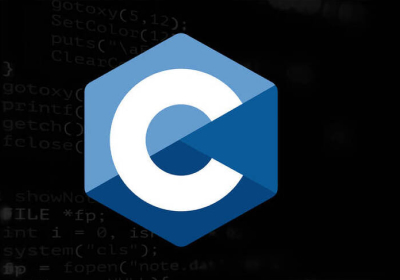Introduction
C is a versatile computer programming language known for its importance and remarkable features, making it a top choice in various applications. It’s employed for creating operating systems (Ex: Linux Kernel) and software for a wide range of computers, from powerful supercomputers to Embedded Systems. Among its many applications, C stands out as the ideal choice for Embedded Systems.
The C programming language, developed by Dennis Ritchie at Bell laboratories of AT&T in 1972, boasts 40+ years of existence without a peer, especially in the realm of Embedded Systems. This article aims to highlight the top-5 reasons for why C remains the top preference for embedded systems.
In the world of programming languages, C serves as a foundational pillar. Around 80% of Embedded Systems are coded using C programming due to its unmatched importance of C language and features of C language. Let us scratch the surface and figure out what makes C so special when it comes to Embedded Systems.
Embedded Systems
Before delving into C, it’s essential to refresh our understanding of Embedded Systems.
Embedded systems represent specialized computer systems designed for particular purpose within larger mechanical or electrical systems. Some of these systems have real-time computing requirements, classifying them as Real-Time Systems (RTS).
In today’s world, these embedded systems are omnipresent, existing in everything from wearable devices to industrial control systems. Essentially, you can view embedded systems as tailor-made software running on specialized hardware.
Given the highly specific nature of the hardware, developers face additional challenges in fine-tuning the software. Moreover, embedded systems typically operate with limited resources, necessitating efficient utilization of hardware resources such as memory. This is precisely where the C language proves its worth.
C excels in managing these intricacies, making it of paramount importance in the development of embedded systems. Its features and capabilities perfectly align with the demands of this specialized field.
Before Use of C Language
The importance of C language in embedded systems programming cannot be overstated. Before its widespread use, developers faced significant challenges. They primarily relied on assembly language, which demanded an in-depth understanding of hardware but lacked the portability required for various hardware platforms.
High-level languages like FORTRAN, while more accessible, were unsuitable due to their high memory usage. However, in the 1970s, C emerged as a game-changer, perfectly balancing low-level control and high-level productivity.
C’s concise syntax and direct hardware access made it the ideal choice for embedded systems. With compilers available for various platforms, C quickly became the go-to language. Decades later, C continues to dominate, excelling in efficiency, portability, and performance. Its enduring impact solidifies its position as the most preferred language for embedded systems development, showcasing the key features of C language that make it invaluable in this field.
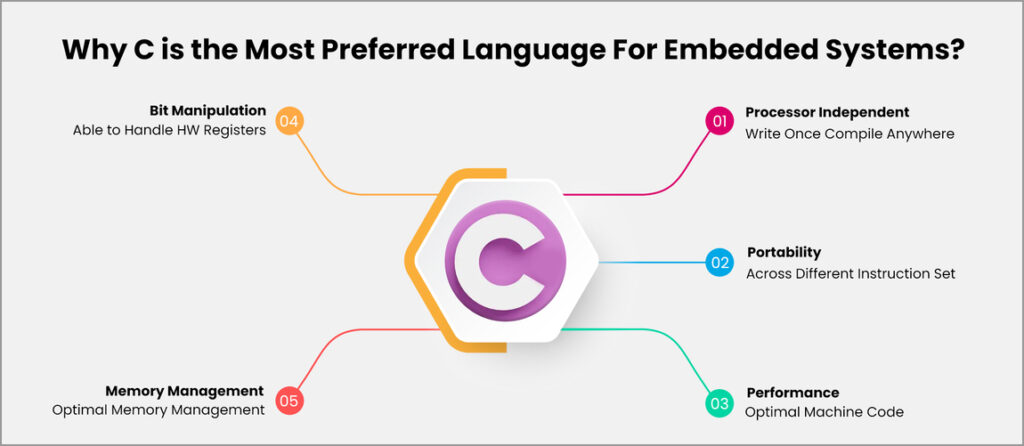
Top 5 Reasons for using C in Embedded Systems
There are specific reasons for why C is the most preferred language for Embedded Systems. Let us look into the top-5 of them as follows.
1.Processor Independent
The C language is versatile, working on various hardware configurations without requiring the same hardware for program execution. It is platform independent, following the concept of Write once, Compile anywhere.
Example :
C programs can be compiled and executed on different hardware with minimal adjustments, mainly involving platform-specific functions and system calls. For example consider an example porting an application from x86 (Intel) processor to ARM processor based hardware. The machine-independent nature of C allows developers to focus on writing code, leaving hardware specifics to the compiler.
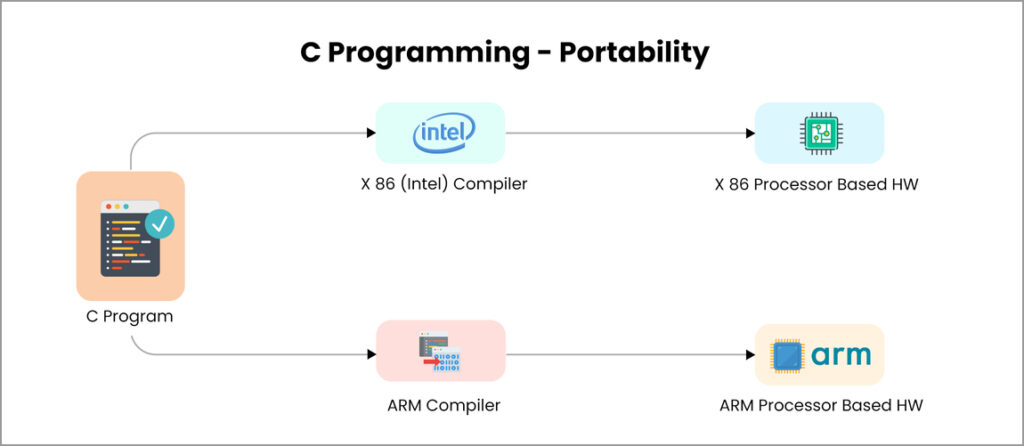
By using processor specific compiler, the compilation process generates hardware-specific assembly code, linked with libraries to create an executable file. While C code remains machine independent, the resulting executable is both machine and platform-dependent.
Having C compilers available for all major processor families, applications developed in one can be moved to another much easier. Hence processor independent nature plays a key role in making C a successful language for Embedded Systems.
2.Portability
Portability of a language is mainly important when an application program must be moved to other operating systems. Code developed in C is more portable and users can compile it on other platforms with fewer modifications. C code is efficient, easy to understand, maintain and debug. A program can be written in one machine and can be run on other machines.
Example 1 - Portability with Typedef
Let us consider a simple example of two integer addition!
The size of the integer variable depends on the underlying machine architecture.
Popularly called Word Size the size can be different. For example, a 32-bit machine occupies 2 bytes whereas an integer variable in a 64-bit machine takes 4-bytes. The max value stored in a 4 byte (unsigned integer) can vary between 0 to 4,294,967,295 whereas in case of 2 byte the range reduces to 0 to 65535.
In case of sum of two numbers (say A and B) exceeding 65535 it will create integer overflow in a 32-bit machine by giving incorrect output. Sample code snippet is given below.
In order to avoid or deduct the issue early, developers can use typedef and create a synonym (ex: 32 for int). This will be helpful when a program is ported to another machine and the developer can make appropriate changes in the code, thereby making the program portable and avoid error.
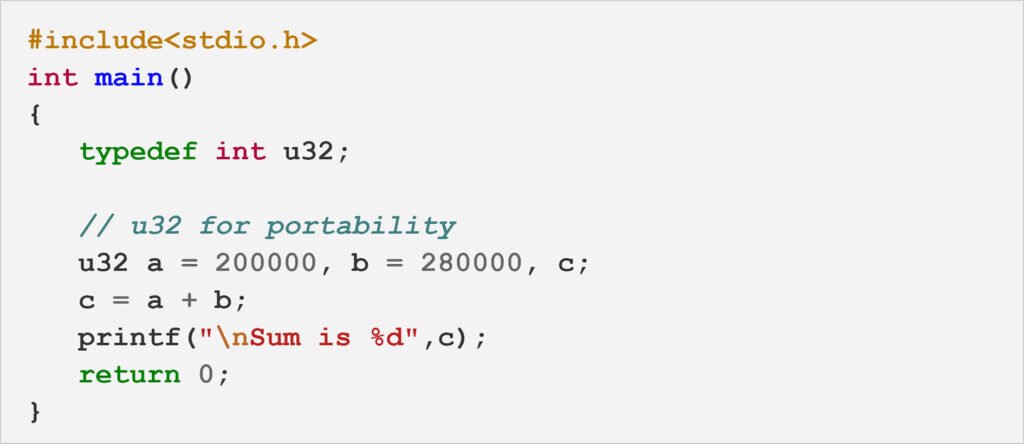
Output :

3.Performance
C code gets compiled into a raw binary executable which can be directly loaded into memory and executed. C provides optimized machine instructions for the given input, which increases the performance of the embedded system. Most of the high-level languages rely on libraries, hence they require more memory which is a major challenge in embedded systems.
For example, In Java, we need JVM (Java Virtual Machine) in addition to the jar files (Executable) which adds additional overhead in terms of performance and memory consumption. Newer languages provide support for garbage collection, dynamic typing etc., which degrades their performance. Since C does none of that, there is little to no overhead.
4.Bit Manipulation
C is a more flexible, structured language that provides low level bit wise data manipulation using the bitwise operators. Using bitwise operators, one could play with available bits, which comes handy when it comes to Embedded Systems (Ex: Handling registers).
Let us understand a basic example.
Example 2 – Setting or Clearing a Bit
To set a bit in a particular number, developers can use bitwise operators. In the below code, the number to be set and bit-position is provided by the user. By generating appropriate masks required results are generated.
Assuming the same case of registers, developers can set or clear a bit in a similar manner thereby getting the ability to program the hardware. Such facilities having a high-level language like C gives a lot of power to developers.
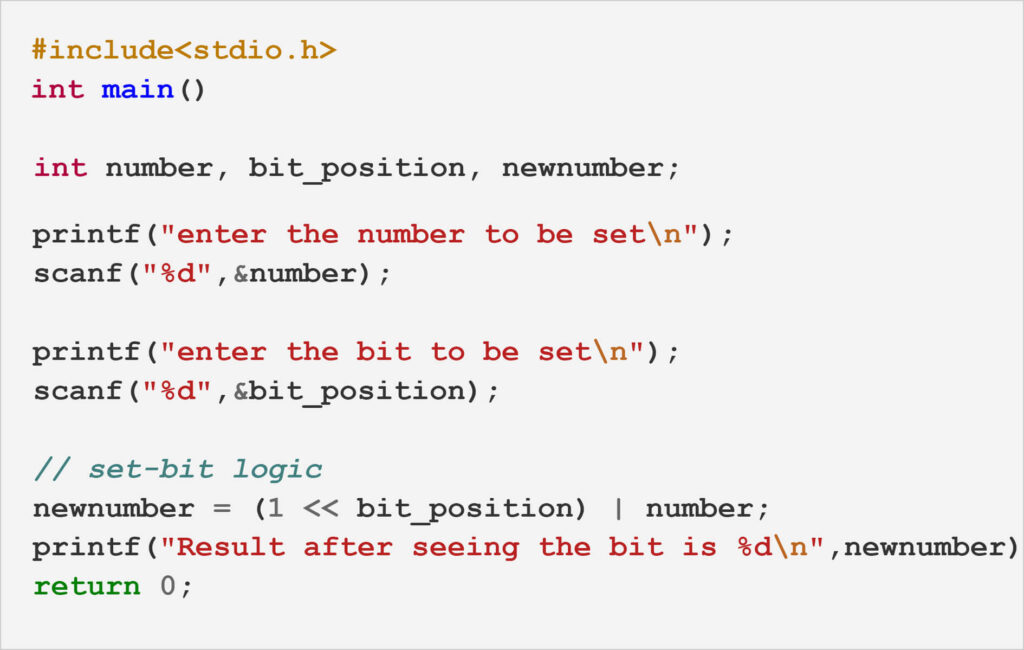
Output :

Example 3 – Encoding Algorithms
The importance of C language lies in its ability to provide direct memory control while retaining the advantageous features of high-level languages. Through the use of pointers, we gain the capability to directly access memory and perform a wide array of operations with efficiency.
Whether the memory requirement is known or unknown, C offers versatility in memory allocation. When the memory requirement is uncertain, dynamic allocation is possible, and when it’s well-defined, static memory allocation can be employed.
Due to these essential features of memory management, C language emerges as the preferred choice for embedded systems, showcasing the significance and distinct features of C language an indispensable tool in programming.
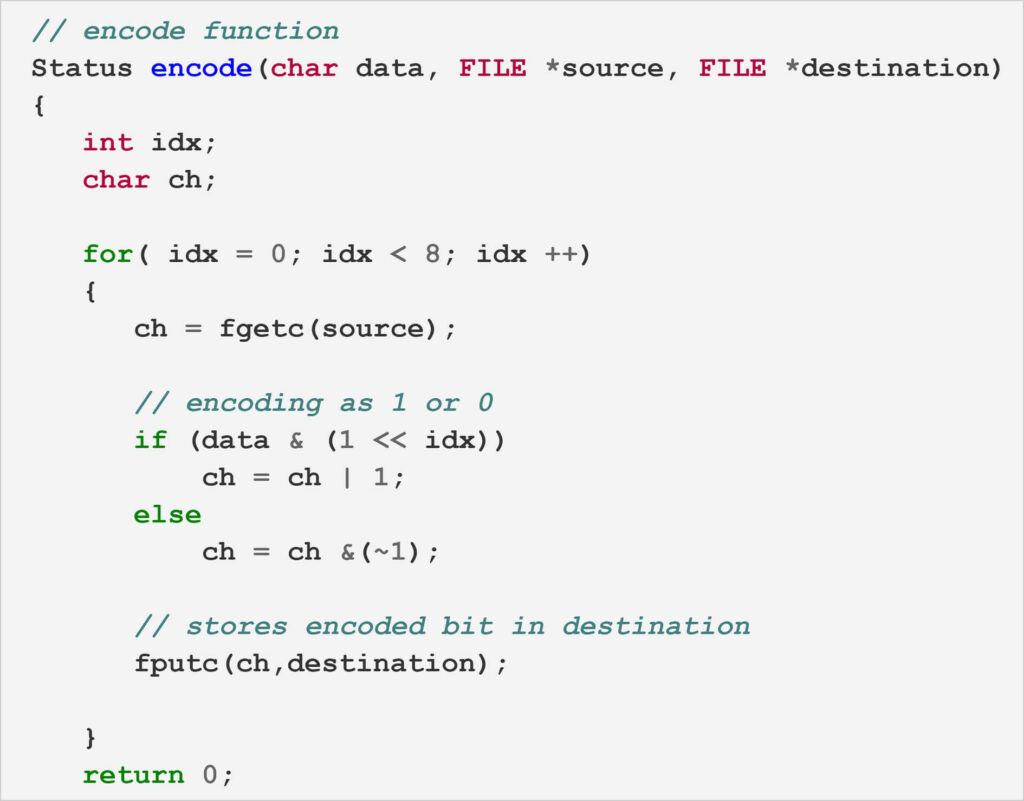
5.Memory Management
C provides direct memory control without sacrificing the benefits of high-level languages. We can directly access memory using pointers and perform various operations using them.
When memory requirement is not known, we can allocate it dynamically and when memory requirement is known, we can allocate the memory statically.
Since such memory management options are available in C it becomes a preferred language for embedded systems.
Example 4 – Simple Dynamic Memory Allocation
When the amount of memory required is unknown, dynamic memory allocation is used, which also helps in optimized memory usage.
In the below code, memory to pointer ptr is dynamically allocated during run time and malloc() returns a void pointer which can be type casted into pointer.
After allocating and performing appropriate operations (ex: addition in this case) the memory is freed up using the free() function.
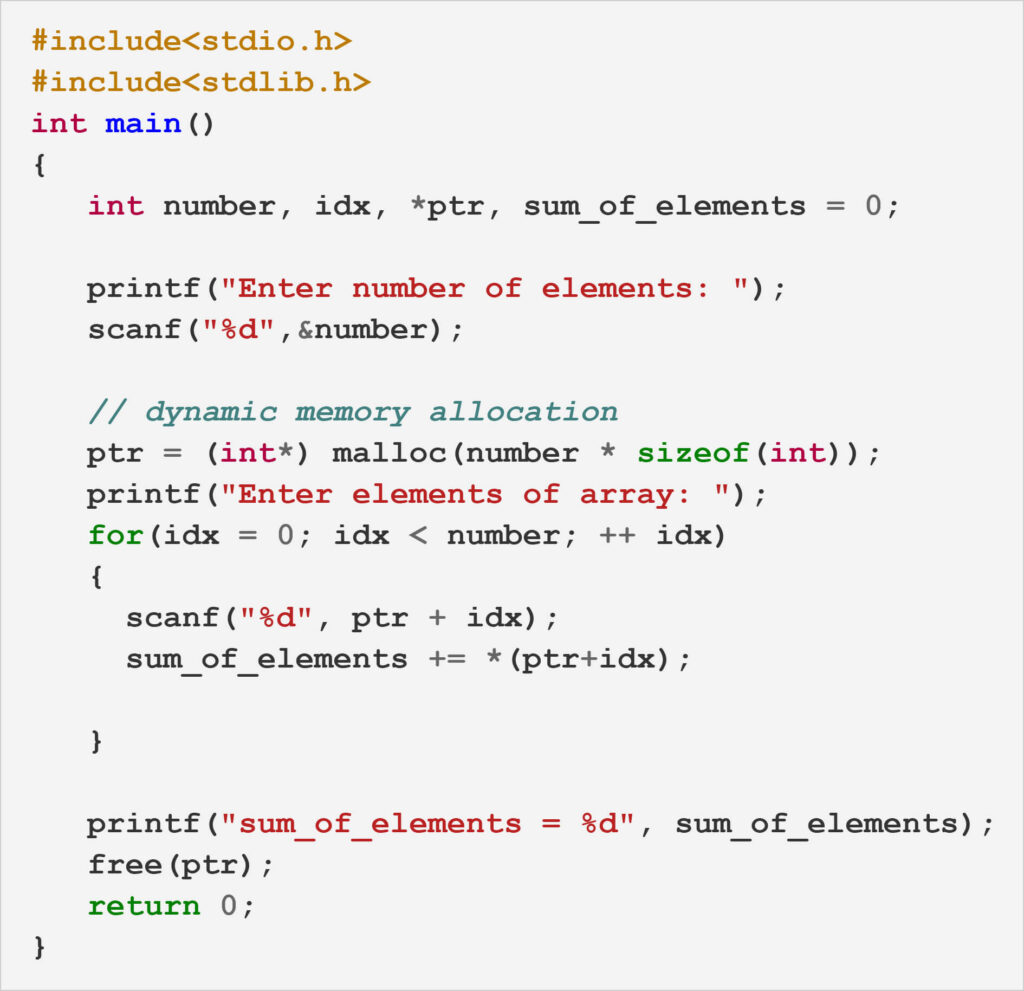
Output :

Example 5 – User Defined Memory Management
C’s pointer feature empowers developers to control memory allocation according to their preferences. For example, in the code given below, 100 bytes of memory are allocated and stored in a void pointer returned by malloc().
These 100 bytes can be utilized as desired. Consider a scenario where continuous storage of length and string contents (len1,string1) | (len2,string2) | (len3,string3) … (lenN,stringN) is required, followed by printing.
As malloc() yields a void pointer, typecasting enables assignment to character or integer pointers for accessing relevant values. C’s pointer typecasting and arithmetic capabilities facilitate such tasks, often complex in other languages.
Embedded systems demand constant memory management and manipulation, such as handling memory frames from hardware via device drivers. C’s robust features become invaluable aids in such scenarios.
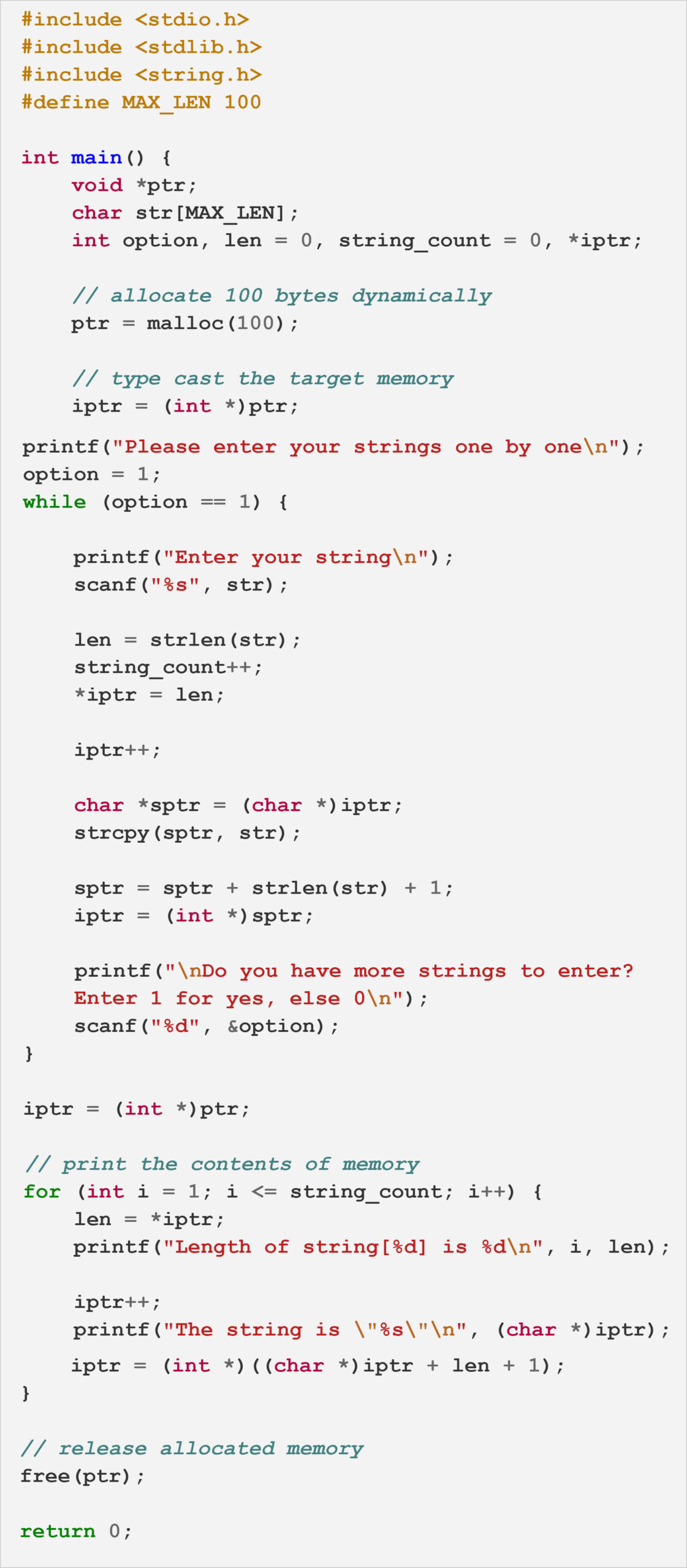
Output :
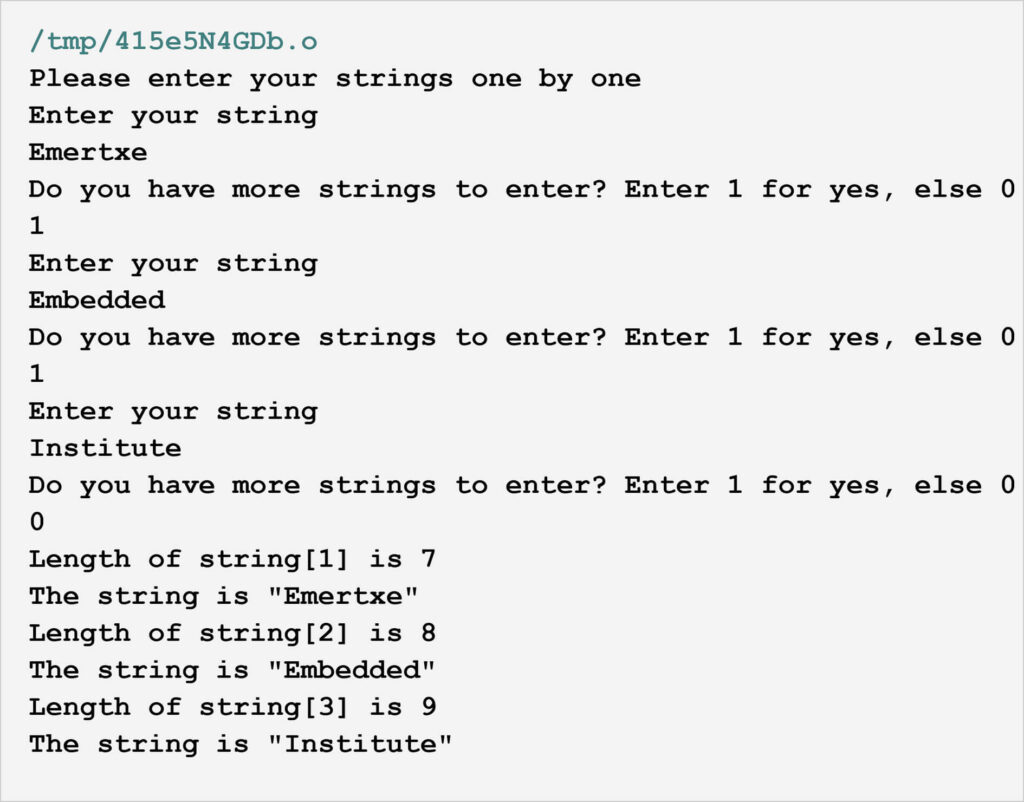
Conclusion
In conclusion, importance of the C programming language in the context of Embedded Systems cannot be overstated. Programming languages are the essential tools that empower developers to transform their ideas into functional programs.
Developing embedded systems poses unique challenges, mainly due to their constrained resources such as limited memory and processing power. Consequently, developers must craft programs that are highly efficient.
This is where the unique features of C language truly shine. With its capabilities, including pointers, bitwise operators, and type definitions, C not only ensures program portability but also enhances efficiency while maintaining processor independence. But there’s a wealth of insights to uncover in this regard. Stay tuned for more updates as we delve deeper into the remarkable features of C language within the realm of Embedded Systems.
Happy learning and enjoy your reading!
| SN | Related Blogs | Links |
|---|---|---|
| 1. | Enumeration in C | Click Here |
| 2. | Difference between typedef and macro in C | Click Here |
| 3. | Dangling Pointers : Be “STRICTLY” Avoided ! | Click Here |
People Also Ask(PAA)
While C is the most prevalent language, there are alternatives depending on specific use cases. Some alternatives include C++, which adds object-oriented features to C, and Rust, a modern systems programming language that provides enhanced memory safety and concurrency.
No, C is not the only language used in embedded systems programming. Depending on the requirements and constraints of the system, other languages like assembly language, C++, Ada, and even Python may be employed. However, C remains the most popular and widely adopted choice.
While C is highly preferred for many embedded systems, the choice of programming language depends on various factors, including system requirements, performance needs, resource constraints, and development team expertise. Different languages may be more suitable for specific use cases, so it’s essential to evaluate the specific needs of the project before selecting a language.
